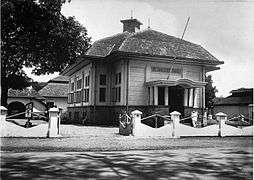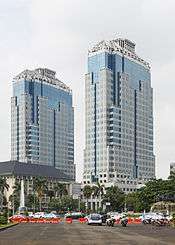Bank Indonesia
| |||
| Headquarters | Jakarta, Indonesia | ||
|---|---|---|---|
| Established | 1 July 1953 | ||
| Governor | Agus Martowardojo | ||
| Central bank of | Indonesia | ||
| Currency |
Indonesian rupiah IDR (ISO 4217) | ||
| Website |
www | ||
Bank Indonesia (BI) is the central bank of the Republic of Indonesia. Agus Martowardojo, formerly the finance minister, is the current governor. The last governor before Agus Martowardojo was Darmin Nasution who resigned at 23 May 2013. Agus Martowardojo was sworn in by president Susilo Bambang Yudhoyono on 23 May 2013.
Finance Minister Sri Mulyani Indrawati was proposed as a candidate for governor of BI in 2009. However, the suggestion did not proceed and she later left the cabinet on 5 May 2010 and moved to the World Bank Group as Managing Director.
By 26 March 2013, panel of Indonesian parliament member approved Finance Minister Agus Martowardojo to become the central bank governor.
History

King William I of the Netherlands granted the right to create a bank in the Indies in 1826 which was named "De Javasche bank" or "The Java Bank". It was founded on 24 January 1828 and later became the circulation bank of the Dutch East Indies. The bank regulated and issued the Netherlands Indies gulden.
In 1881, an office of the Java Bank was opened in Amsterdam. Later followed the opening of an office in New York. By 1930 the bank owned sixteen office branches in the Dutch East-Indies: Bandung, Cirebon, Semarang, Yogyakarta, Surakarta, Surabaja, Malang, Kediri, Banda Aceh, Medan, Padang, Palembang, Banjarmasin, Pontianak, Makassar, and Manado.
The Java Bank was operated as a private bank and individuals as well as industries etc. could get help in the bank’s offices.[1]

Bank Indonesia was founded on 1 July 1953 from the nationalisation of De Javasche Bank, three years after the recognition of Indonesia's independence by Netherlands. [2]
For the next 15 years, the Bank of Indonesia carried on commercial activities as well as acting as the nation’s national bank and is in charge in issuing Rupiah currency.
This came to an end with the Law No.13/1968 on the Central Bank, which was subsequently replaced by Law No.23/1999, giving the bank independence.
Thereafter, the bank reported to the parliament (People's Representative Council) instead of the president, and the bank’s governor was no longer a member of the cabinet.
Organization
The bank is led by the board of governors, comprising the governor, a senior deputy governor and at between four and seven deputy governors.
The governor and deputy governors serve a five-year term, and are eligible for re-election for a maximum of two terms. The governor and senior deputy governor are nominated and appointed by the president, with approval from the People's Representative Council. Deputy governors are nominated by the governor and appointed by the president, with approval of the People's Representative Council. The president has no power to dismiss a member of the board, except when a board member voluntarily resigns, is permanently handicapped, or is proven guilty of criminal offence.
The Board of Governors Meeting is the bank’s highest decision-making forum. It is held at least once a month to decide on general policy on monetary affairs, and at least once a week to evaluate policy implementation or to decide on other strategic and principle policy.
The Bank is active in promoting financial inclusion policy and is a leading member of the Alliance for Financial Inclusion. It hosted AFI's second annual Global Policy Forum (GPF) in Bali, Indonesia in 2010. On 14 May 2012 Bank Indonesia announced it would be making specific commitments to financial inclusion under the Maya Declaration.
By 30 December 2013, the bank's microprudential supervision functions will be transferred to Financial Services Authority (Indonesia). In the future, the bank will maintain Indonesian financial system and monetary stability through mixture of monetary and macroprudential instruments and policies.
Strategic objectives
The Bank describes its strategic objectives as being :
- Maintain monetary stability
- Maintain the financial sustainability of the Bank of Indonesia
- Strengthen the effectiveness of monetary management
- Create a sound and effective banking system and financial system stability
- Maintain the security and effectiveness of the payment system
- Increase the effectiveness of Good Governance implementation
- Strengthen the organisation and build highly competent human resources with the support of a knowledge-based work culture
- Integrate the Bank of Indonesia's transformation in line with Bank Indonesia's destination statement of 2008
National Payment Gateway
The aim is to integrate all Automated Teller Machines in ASEAN countries, beginning with integration first in each country. On 16 January 2012 interconnection between Bank Mandiri ATMs and Bank Central Asia ATMs (Prima ATMs) was launched.[3]
Bank Indonesia Liquidity Support
Bank Indonesia Liquidity Support is an Indonesian government policy that was formulated with Bank Indonesia in the crisis period and executed by Bank Indonesia to rescue the monetary and banking system as well as the economy as a whole. It was partly based on the instruction and command of the President in the limited meeting of economic, finance, and development supervision and production and distribution on 3 September 1997.
This policy was provided under various emergency lending schemes (Fasilitas Diskonto I/Fasdis I, Fasdis II, Fasilitas SBPU, Fasilitas SBPUK, Fasilitas Diskonto Baru and Dana Talangan).
Offices
BI operates 37 offices across Indonesia, and four representative offices in New York City, London, Tokyo and Singapore. In addition, Bank Indonesia also operates a well-appointed museum (Museum Bank Indonesia) which is housed in the former De Javasche Bank head office building in the (Kota) area of old Jakarta.
Indonesian offices
Bank Indonesia have branches in almost all major cities of Indonesia.
-

Bank Indonesia in Medan
-

Bank Indonesia in Banjarmasin
-

Bank Indonesia in Surakarta
-

Bank Indonesia in Yogyakarta
-
Bank Indonesia in Padang
-

Bank Indonesia in Palembang (1950s)
-

Town Hall and Bank Indonesia in Medan (formerly De Javasche Bank)
-

De Javasche Bank in Surabaya
-

De Javasche Bank in Malang
-

De Javasche Bank in Banda Aceh
Worldwide representative offices
-
 Singapore: 11 Collyer Quay 08-01 The Arcade Singapore 049317.[4]
Singapore: 11 Collyer Quay 08-01 The Arcade Singapore 049317.[4] -
 London: 10 City Road, London EC 1Y 2EH.
London: 10 City Road, London EC 1Y 2EH. -
 Tokyo: New Kokusai Building Room 906 No.4 - 1, Marunouchi 3 - Chome Chiyoda-ku, Tokyo, 100-0005 Japan.
Tokyo: New Kokusai Building Room 906 No.4 - 1, Marunouchi 3 - Chome Chiyoda-ku, Tokyo, 100-0005 Japan. -
 New York: One Liberty Plaza 165 Broadway, 31st floor New York N.Y. 10006.[5]
New York: One Liberty Plaza 165 Broadway, 31st floor New York N.Y. 10006.[5]
List of Governors
| Name | Period |
| Radius Prawiro | 1966–1973 |
| Rachmat Saleh | 1973–1983 |
| Arifin Siregar | 1983–1988 |
| Adrianus Mooy | 1988–1993 |
| J. Soedradjad Djiwandono | 1993–1998 |
| Syahril Sabirin | 1998–2003 |
| Burhanuddin Abdullah | 2003–2008 |
| Boediono | 2008–2009 |
| Darmin Nasution | 2009–2013 |
| Agus Martowardojo | 2013– |
See also
- Economy of Indonesia
- Indonesian rupiah
- List of banks in Indonesia
- Payment system
- Real-time gross settlement
References
- ↑ http://www.indonesia-dutchcolonialheritage.nl/jakhistoricalsites/Hosp.pdf
- ↑ Cribb, Robert & Kahin, Audrey (2004). Historical Dictionary of Indonesia. Historical dictionaries of Asia, Oceania, and the Middle East (2nd ed.). Lanham, MD: Scarecrow Press. pp. 45–46. ISBN 978-0-8108-4935-8.
- ↑ "Senin Besok, ATM Mandiri Mulai Koneksi BCA". 14 January 2012.
- ↑ "MASNET". mas.gov.sg. Retrieved 7 July 2015.
- ↑ "Halaman Tidak Dapat Ditemukan - Bank Sentral Republik Indonesia". bi.go.id. Retrieved 7 July 2015.
External links
Coordinates: 6°10′54″S 106°49′17″E / 6.18167°S 106.82139°E
